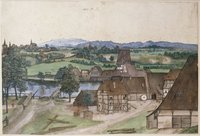Das Fragment ist eine Nachzeichnung oder Pause nach Friedrich Gilly`s Aquarell „Antike Möbel“ (Stadtmuseum Berlin, Grafikslg., Inv. Nr. VII 62/337w). Das fragile imprägnierte Papier wurde laut kürzlich erfolgter mikroskopischer Untersuchung wohl spiegelverkehrt auf einen Karton aufgezogen. Dargestellt sind ein Kandelaber mit Schale, ein Postament mit Lyra, ein Hocker und ein Teil der Lehne eines Sessels vor einer Wand mit gerafften Behängen. Auf der Originalzeichnung befinden sich des Weiteren antikes Mobiliar und Gegenstände der Kleinkunst.
Text: Birgit Kropmanns (2012)
en

